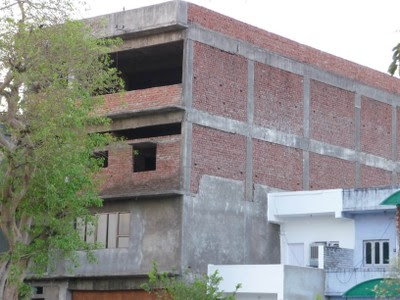 |
| A masonry infilled reinforced concrete frame |
In countries with stringently applied Codes of Practice the absence of a well recognized method of design for infilled frames has severely restricted their use for bracing. It has been more usual in such countries when designing an infilled frame structure to arrange for the frame to carry the total vertical and horizontal loading and to include the infills on the assumption that, with precautions taken to
avoid load being transferred to them. the infills do not participate as part of the primary structure. It is evident from the frequently observed diagonal cracking of such infill walls that the approach is not always valid. The walls do sometimes attract significant bracing loads and in so doing modify the structure's mode or behavior and the forces in the frame. In such cases it would have been better to design the walls for the lateral loads and the frame to allow for its modified mode of behavior.
To brace a structure, the arrangement of infill walls within the three-dimensional frame must satisfy the same requirements as for the layout of bracing in a steel structure. Within any storey the infills must be statically capable of resisting horizontal shear in two orhogonal directions as well as resisting a horizontal torque. To achieve this there must be at least three infills that may not be all parallel or all concurrent. They must of course also be able to satisfy the strength and stiffness requirements.
Certain reservations arise in the use of infilled frames for bracing a structure. For example it is possible that as part of a renovation project partition walls are removed with the result that the structure becomes inadequately braced. Precautions against this either by including a generously excessive number of bracing walls or by somehow permanently identifying the vital bracing walls, should be considered as part of the design. A reservation against their use where earthquake resistance is a factor is that the walls might be shaken out of their frames transversely and consequently be of little use as bracing in their own planes. On the basis of substantial field evidence this fear is well justified. Their use in earthquake regions, therefore should be with the additional provision that the walls are reinforced and anchored into the surrounding frame with sufficient strength to withstand their own transverse inertial forces.
